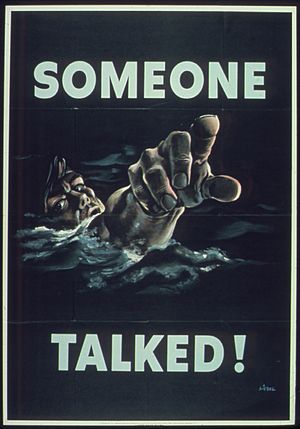Fritz Siebel facts for kids
Quick facts for kids
Fritz Siebel
|
|
|---|---|
 |
|
| Born |
Frederick Siebel
1913-12-19 |
| Died | 1991-12 |
| Known for | illustration, design |
Frederick "Fritz" Siebel (born December 19, 1913 – died December 1991) was a talented artist from Austria who became famous in America. He was well known for his amazing poster during World War II called "Someone Talked." He also drew the pictures for many popular children's books, including the much-loved Amelia Bedelia series by Peggy Parish.
The Life of Fritz Siebel
Growing Up in Austria
Fritz Siebel was born in Vienna, Austria, on December 19, 1913. His father was from Bohemia, and his mother was from Louny. When he was a child, Fritz and his brothers and sisters spent their summers on their family's farm in Czechoslovakia.
He studied art at the Kunstgewerbeschule Vienna, which is now called the University of Applied Arts Vienna. There, he learned about illustration and designing sets for plays. Because he had citizenship in two countries, he joined the Czech army from 1934 to 1936.
Moving to the United States
In 1936, Fritz Siebel moved to the United States. His family joined him in 1937, and they all made their home in New York City. Sadly, other relatives who stayed in Europe did not survive the terrible events of the Holocaust.
His Final Years
Frederick Siebel passed away in New York City in December 1991.
Fritz Siebel's Art and Design Work
Starting His Career in the USA
After moving to New York City, Fritz Siebel began working as an artist. He drew posters and other advertisements for Paramount Pictures, a big movie studio. He also showed people how to ski using Austrian techniques at a famous store called Saks Fifth Avenue.
World War II and a Famous Poster
During World War II, Fritz Siebel served in the United States Army from 1941 to 1943. In 1942, he entered a national contest to design posters about national security. Eleanor Roosevelt, the First Lady of the United States, was one of the judges.
His poster, titled "Someone Talked," won several awards. It became very famous and helped remind people to be careful about what they said during the war.
Working for Magazines and Advertisements
After his success with the "Someone Talked" poster, many companies wanted Fritz Siebel's artwork. He started creating drawings for advertisements and popular magazines. He worked with well-known magazines like Collier's Magazine, Holiday Magazine, and The Saturday Evening Post. He also designed ads for drinks like Ballantine Beer and Schlitz beer.
Creating Mr. Clean
In 1957, an advertising company hired Siebel to create a mascot for a new cleaning product. This product was called "Mr. Clean" and was made by Procter & Gamble.
Fritz Siebel designed the smiling, bald man with an earring that we all know today. This character is called different names in other countries, like "Master Proper" in Germany or "Monsieur Propre" in France. As part of his agreement, Siebel gave up all rights to his creation. This means he was not given credit for creating Mr. Clean; the copyright belongs only to Procter & Gamble.
Illustrating Children's Books
In 1958, Fritz Siebel began drawing pictures for children's books. His first two best-selling books were "A Fly Went By" and "Stop that Ball!" Both were written by Mike McClintock. These books were part of the "Beginner Books" series from Random House. This series was started by Phyllis Fraser and Dr. Seuss, along with Dr. Seuss's wife, Helen Palmer Geisel.
In 1962, he illustrated "Dr. Dick" by Dorothy Kunhardt. This book was published by Harper and Row, which is now HarperCollins. This same publisher also released his most famous children's book, Amelia Bedelia, written by Peggy Parish.
Starting His Own Design Company
In the 1960s, Siebel started his own company called Frederick Siebel Associates. His company offered "creative design for integrated programs of packaging, store display, and other sales-related materials." This means they helped design how products looked in stores and how they were packaged.
Later, the company changed its name to "Siebel Marketing Company." In 1998, John Caggiano joined the company, and it became "Caggiano & Siebel Advertising."


